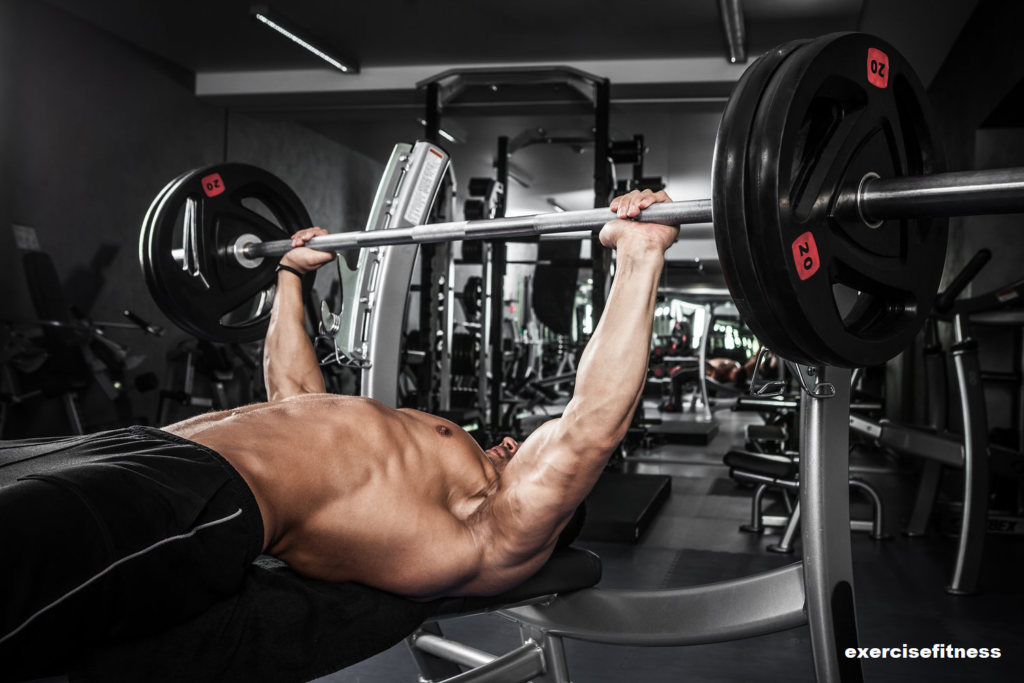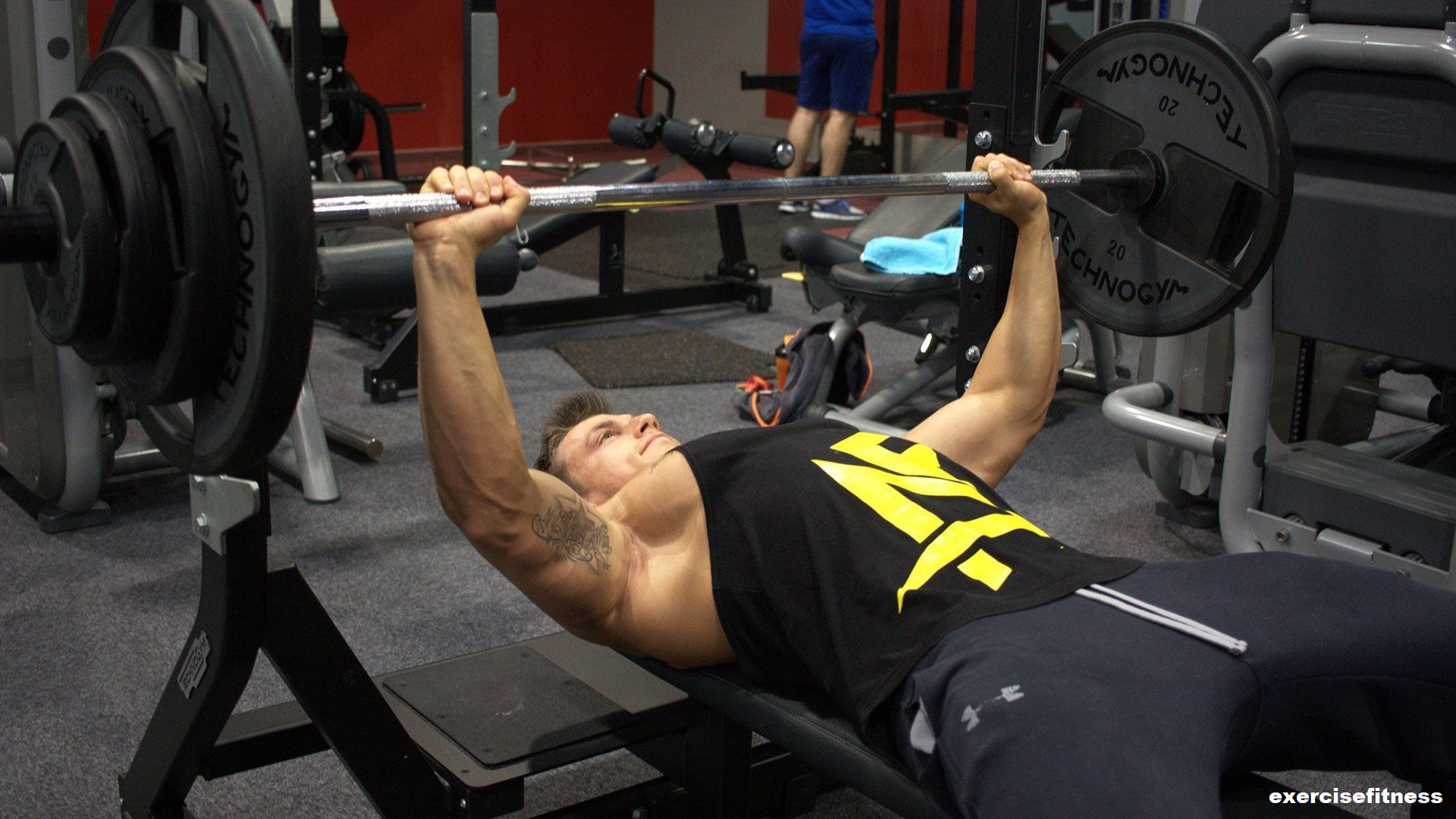Introduction:

The bench press is a key exercise for building muscle and power in the chest, shoulders, and triceps. It’s great for both beginners and experienced lifters. This article will cover the mechanics, benefits, and best practices for the bench press.
The Mechanics of the Bench Press
The bench press works multiple muscles at once. Here’s how to do it right:
- Set Up: Lie flat on a bench with your eyes under the barbell. Feet should be flat, and lower back slightly arched.
- Grip: Hold the bar with a grip wider than your shoulders. Palms should face forward, thumbs wrapped around the bar.
- Unrack the Bar: Push the bar up to lift it off the rack. Place it over your chest with arms fully extended.
- Lower the Bar: Slowly lower the bar to your mid-chest. Keep elbows at a 45-degree angle.
- Press Up: Push the bar back up to the start in a controlled motion. Extend your arms fully.
- Repeat: Do the desired number of reps, keeping form.
Muscles Worked
The bench press targets several muscles:
- Pectoralis Major: The chest muscles for pushing.
- Deltoids: Shoulder muscles helping lift the bar.
- Triceps Brachii: Muscles at the back of your upper arms.
- Latissimus Dorsi and Rhomboids: Back muscles for stability.
- Core Muscles: Keep you stable and in the right position.
Benefits of the Bench Press
1. Builds Upper Body Strength
The bench press is top-notch for building pressing power and upper body strength. It’s essential for many athletic and daily activities.
2. Enhances Muscle Mass
Regular bench pressing helps grow muscle in the chest, shoulders, and triceps. This leads to a more muscular and balanced body.
3. Improves Bone Density
Resistance training, like the bench press, stimulates bone growth. It helps prevent bone density loss with age.
4. Boosts Athletic Performance
The strength gained from bench pressing improves performance in sports needing pushing or throwing.
5. Versatility and Adaptability
The bench press can be modified for different fitness levels and goals.
Common Variations
1. Flat Bench Press
- Focus: Overall chest development.
- Equipment: Barbell or dumbbells.
2. Incline Bench Press
- Focus: Upper chest and shoulders.
- Angle: Set the bench to a 30-45 degree incline.
3. Decline Bench Press
- Focus: Lower chest.
- Angle: Adjust the bench to a slight decline.
4. Close-Grip Bench Press
- Focus: Triceps and inner chest.
- Grip: Hands closer together on the bar.
5. Dumbbell Bench Press
- Focus: Stabilizer muscles and range of motion.
- Equipment: Dumbbells instead of a barbell.
6. Floor Press
- Focus: Lockout strength and triceps.
- Equipment: Barbell or dumbbells.
Tips for Maximizing Bench Press Performance
- Warm Up Properly: Do a dynamic warm-up to get your muscles ready and prevent injuries.
- Focus on Form: Keep the right alignment and control to make sure it’s safe and effective.
- Progress Gradually: Add weight slowly to avoid stressing your muscles too much too soon.
- Incorporate Assistance Exercises: Work on supporting muscles with push-ups, tricep dips, and shoulder presses.
- Use a Spotter: Have someone help you with heavy lifts for safety.
- Track Progress: Keep a workout log to see how you’re getting stronger and adjust your routine as needed.
Common Mistakes to Avoid
- Arching the Back Excessively: Avoid over-arching to prevent back strain and improve the exercise’s effectiveness.
- Flared Elbows: Keep your elbows at a 45-degree angle to avoid shoulder strain.
- Bouncing the Bar: Lower the bar slowly instead of bouncing it off your chest.
- Neglecting Warm-Ups: Don’t skip warm-ups to avoid injuries.
- Using Too Much Weight: Focus on form and control over lifting heavy weights.
Incorporating Bench Press Into Your Routine
To get the most out of the bench press, include it in a well-rounded strength training program. Here’s a sample routine:
- Warm-Up: Start with 5-10 minutes of light cardio and dynamic stretches.
- Bench Press: Do 3-5 sets of 8-12 reps, adjusting the weight based on your goals.
- Accessory Exercises: Add dumbbell flies, push-ups, and tricep dips to complement your bench press training.
- Cooldown: Finish with static stretches to help with recovery and flexibility.
Conclusion:
The bench press is key for building upper body strength, muscle, and athletic performance. Mastering the technique, trying different variations, and following best practices can make the bench press a powerful tool in your fitness journey. It’s great for building muscle, improving strength, or enhancing sports performance.
